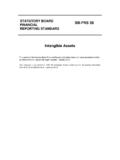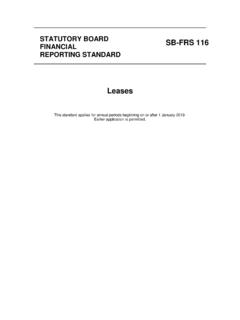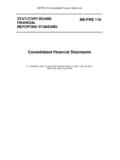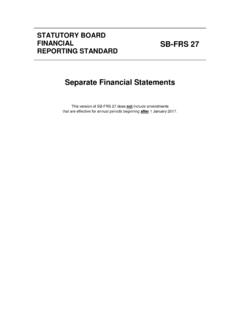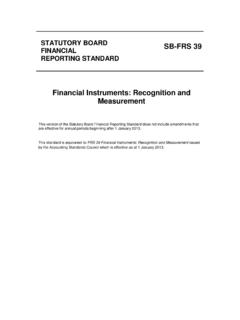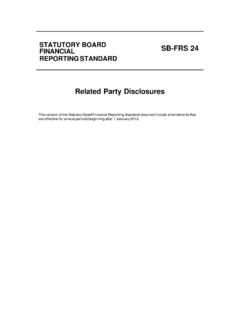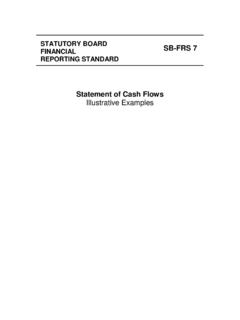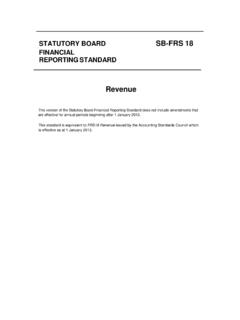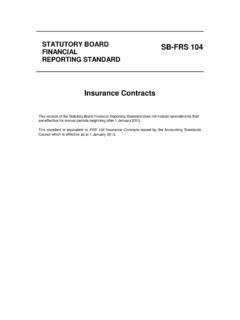Transcription of Impairment of Assets - Accounting Standards for …
1 STATUTORY BOARD FINANCIAL SB-FRS 36 REPORTING STANDARD Impairment of Assets SB-FRS 36 Impairment of Assets applies to Statutory Boards for annual periods beginning on or after 1 January 2009. This Standard is equivalent to FRS 36 Impairment of Assets by the Council on Corporate Disclosure and Governance on 22 February 2007. Contents paragraphs Statutory Board Financial Reporting Standard 36 Impairment of Assets OBJECTIVE 1 SCOPE 2-5 DEFINITIONS 6 IDENTIFYING AN asset THAT MAY BE IMPAIRED 7-17 MEASURING RECOVERABLE AMOUNT 18-57 Measuring the Recoverable Amount of an Intangible asset with an Indefinite Useful Life 24 Fair Value less Costs to Sell 25-29 Value in Use 30-57 Basis for Estimates of Future Cash Flows 33-38 Composition of Estimates of Future Cash Flows 39-53 Foreign Currency Future Cash Flows 54 Discount Rate 55-57 RECOGNISING AND MEASURING AN Impairment LOSS 58-64 CASH-GENERATING UNITS AND GOODWILL 65-108 Identifying the Cash-generating Unit to Which an asset Belongs 66-73
2 Recoverable Amount and Carrying Amount of a Cash-generating Unit 74-103 Goodwill 80-99 Allocating Goodwill to Cash-generating Units 80-87 Testing Cash-generating Units with Goodwill for Impairment 88-90 Minority Interest 91-95 Timing of Impairment Tests 96-99 Corporate Assets 100-103 Impairment Loss for a Cash-generating Unit 104-108 REVERSING AN Impairment LOSS 109-125 Reversing an Impairment Loss for an Individual asset 117-121 Reversing an Impairment Loss for a Cash-generating Unit 122-123 Reversing an Impairment Loss for Goodwill 124-125 DISCLOSURE 126-137 Estimates used to Measure Recoverable Amounts of Cash-generating Units Containing Goodwill or Intangible Assets with Indefinite Useful Lives 134-137 EFFECTIVE DATE 138-140 APPENDIX A Using Present Value Techniques to Measure Value in Use A1-A21 APPENDIX B Amendment to SB-FRS 16 B1 ILLUSTRATIVE EXAMPLES 3 Statutory Board Financial Reporting Standard 36 Impairment of Assets (SB-FRS 36) is set out in paragraphs 1-141 and Appendices A and B.
3 All the paragraphs have equal authority. SB-FRS 36 should be read in the context of its objective, the Preface to Statutory Board Financial Reporting Standards and the Framework for the Preparation and Presentation of Financial Statements. SB-FRS 8 Accounting Policies, Changes in Accounting Estimates and Errors provides a basis for selecting and applying Accounting policies in the absence of explicit guidance. Statutory Board Financial Reporting Standard FRS 36 Impairment of Assets Objective 1.
4 The objective of this Standard is to prescribe the procedures that an entity applies to ensure that its Assets are carried at no more than their recoverable amount. An asset is carried at more than its recoverable amount if its carrying amount exceeds the amount to be recovered through use or sale of the asset . If this is the case, the asset is described as impaired and the Standard requires the entity to recognise an Impairment loss. The Standard also specifies when an entity should reverse an Impairment loss and prescribes disclosures. Scope 2. This Standard shall be applied in Accounting for the Impairment of all Assets , other than: (a) inventories (see SB-FRS 2 Inventories); (b) Assets arising from construction contracts (see SB-FRS 11 Construction Contracts); (c) deferred tax Assets (see SB-FRS 12 Income Taxes); (d) Assets arising from employee benefits (see SB-FRS 19 Employee Benefits); (e) financial Assets that are within the scope of SB-FRS 39 Financial Instruments: Recognition and Measurement; (f) investment property that is measured at fair value (see SB-FRS 40 Investment Property); (g) biological Assets related to agricultural activity that are measured at fair value less estimated point-of-sale costs (see SB-FRS 41 Agriculture); (h) deferred acquisition costs, and intangible Assets , arising from an insurer s contractual rights under insurance contracts within the scope of SB-FRS 104 Insurance Contracts.
5 And (i) non-current Assets (or disposal groups) classified as held for sale in accordance with SB-FRS 105 Non-current Assets Held for Sale and Discontinued Operations. 3. This Standard does not apply to inventories, Assets arising from construction contracts, deferred tax Assets , Assets arising from employee benefits, or Assets classified as held for sale (or included in a disposal group that is classified as held for sale) because existing Standards applicable to these Assets contain requirements for recognising and measuring these Assets . 4. This Standard applies to financial Assets classified as: (a) subsidiaries, as defined in SB-FRS 27 Consolidated and Separate Financial Statements; (b) associates, as defined in SB-FRS 28 Investments in Associates; and (c) joint ventures, as defined in SB-FRS 31 Interests in Joint Ventures. For Impairment of other financial Assets , refer to SB-FRS 39.
6 1 5. This Standard does not apply to financial Assets within the scope of SB-FRS 39, investment property measured at fair value in accordance with SB-FRS 40, or biological Assets related to agricultural activity measured at fair value less estimated point-of-sale costs in accordance with SB-FRS 41.
7 However, this Standard applies to Assets that are carried at revalued amount ( fair value) in accordance with other Standards , such as the revaluation model in SB-FRS 16 Property, Plant and Equipment. Identifying whether a revalued asset may be impaired depends on the basis used to determine fair value: (a) if the asset s fair value is its market value, the only difference between the asset s fair value and its fair value less costs to sell is the direct incremental costs to dispose of the asset : (i) if the disposal costs are negligible, the recoverable amount of the revalued asset is necessarily close to, or greater than, its revalued amount ( fair value). In this case, after the revaluation requirements have been applied, it is unlikely that the revalued asset is impaired and recoverable amount need not be estimated. (ii) if the disposal costs are not negligible, the fair value less costs to sell of the revalued asset is necessarily less than its fair value.
8 Therefore, the revalued asset will be impaired if its value in use is less than its revalued amount ( fair value). In this case, after the revaluation requirements have been applied, an entity applies this Standard to determine whether the asset may be impaired. (b) if the asset s fair value is determined on a basis other than its market value, its revalued amount ( fair value) may be greater or lower than its recoverable amount. Hence, after the revaluation requirements have been applied, an entity applies this Standard to determine whether the asset may be impaired. Definitions 6. The following terms are used in this Standard with the meanings specified: An active market is a market in which all the following conditions exist: (a) the items traded within the market are homogeneous; (b) willing buyers and sellers can normally be found at any time; and (c) prices are available to the public. The agreement date for a business combination is the date that a substantive agreement between the combining parties is reached and, in the case of publicly listed entities, announced to the public.
9 In the case of a hostile takeover, the earliest date that a substantive agreement between the combining parties is reached is the date that a sufficient number of the acquiree s owners have accepted the acquirer s offer for the acquirer to obtain control of the acquiree. Carrying amount is the amount at which an asset is recognised after deducting any accumulated depreciation (amortisation) and accumulated Impairment losses thereon. A cash-generating unit is the smallest identifiable group of Assets that generates cash inflows that are largely independent of the cash inflows from other Assets or groups of Assets . Corporate Assets are Assets other than goodwill that contribute to the future cash flows of both the cash-generating unit under review and other cash-generating units. 2 Costs of disposal are incremental costs directly attributable to the disposal of an asset or cash-generating unit, excluding finance costs and income tax expense.
10 Depreciable amount is the cost of an asset , or other amount substituted for cost in the financial statements, less its residual value. Depreciation (Amortisation) is the systematic allocation of the depreciable amount of an asset over its useful life. Fair value less costs to sell is the amount obtainable from the sale of an asset or cash-generating unit in an arm s length transaction between knowledgeable, willing parties, less the costs of disposal. An Impairment loss is the amount by which the carrying amount of an asset or a cash-generating unit exceeds its recoverable amount. The recoverable amount of an asset or a cash-generating unit is the higher of its fair value less costs to sell and its value in use. Useful life is either: (a) the period of time over which an asset is expected to be used by the entity; or (b) the number of production or similar units expected to be obtained from the asset by the entity. Value in use is the present value of the future cash flows expected to be derived from an asset or cash-generating unit.
